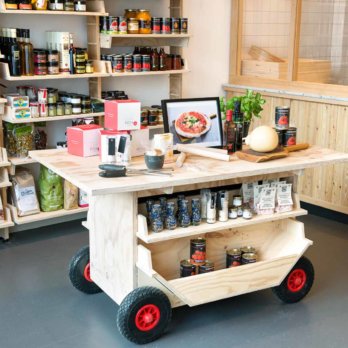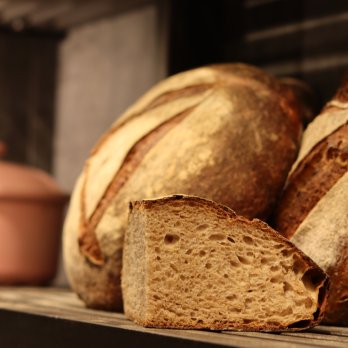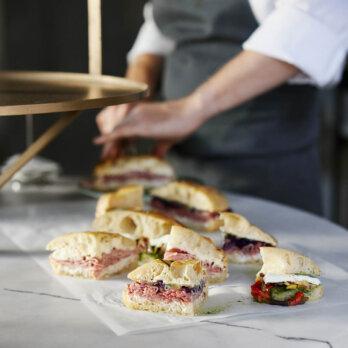Opening Times
Wednesday to Friday: 1:00pm - 6:00pm
Saturday: noon - 5:00pm
Address
Café Bärbucha
Eisenacher Str. 73
10823 Berlin-Schöneberg
.How to get there
"Fermenting is part of the food culture in Poland. We grew up with it," says Elisabeth, who, together with her husband Tadeusz, runs Café Bärbucha in Schöneberg. It is a fermenter and delicatessen for kombucha and other ferments in one. When the two founded it in 2015, ferments were still hard to find in Berlin.
Since they, due to this lack of supply, produced for their own needs, they had the idea of filling this gap in the market. However, they were notably lacking in kombucha, so they began producing Berlin's first kombucha - appropriately named Bärbucha.
Tadeusz is a trained chef who brings his kitchen experience to the production of ferments and kombucha. "We want to show people how fermentation works and how many possibilities it offers. We want to give them high-quality products and show the advantage they can have over industrially produced goods."
So the two can educate not only about the production process but also about the effects of different types of kombucha and ferments on the body. After all, fermented foods are not only tasty but, above all, healthy. The two owners of Café Bärbucha make all the products themselves, using traditional handicraft methods. They are fermented in jars and earthenware, respecting the needs of the respective ingredients and observing the necessary ripening time.
This handwork is essential to achieve the delicate taste of kombucha. All products here are of raw food quality, finely bubbly and very nuanced in flavour. Nothing is pasteurised and must always be refrigerated, preserving natural, healthy ingredients and flavour. Likewise, the carbonic acid of Bärbucha is produced naturally, without artificial carbonation, which makes the drink more delicate. An essential distinguishing feature compared to industrial kombucha.
The basis for their kombucha is a so-called Scoby, Symbiotic Colony of Bacteria and Yeast. The scoby, which floats visibly in layers in jars behind the shop counter, is demanding but versatile. It is an integral part of the traditional fermentation of kombucha but can also be used in other diverse ways. For example, it can be turned into leather, and Elisabeth even makes face masks out of it.
But it's not just the scoby that catches the eye when you enter Café Bärbucha. Large jars of salted lemons, various vegetables, chilli, garlic, and much more tempt you even in the shop window. Behind the counter, there are multiple components of kombucha to look at. The various ferments and kombuchas are gathered in a large row of refrigerators. As a result, the entire Café Bärbucha radiates warmth, closeness to nature and freshness.
Kombucha is, of course, the central theme here. Elisabeth and Tadeusz produce 22 different varieties in three lines: the beginner-friendly classic line with a distinct tea flavour, the high-quality premium line, more nuanced and complex, and the special line made from herbs and medicinal plants. Only natural ingredients are used in their production, primarily tea or components that are drunk like teas, such as lapacho or hemp.
The differences can be significant, both in taste, from tart to sweet, and in colour and carbonation. Since the refridgeration chain must be maintained, kombucha can only be delivered as an order during the cold season. When tasting, we start with Boeng, a unique kombucha made from oolong tea. It tastes sweet and sour, focusing on the balance of the tea flavour.
Jun, appropriately for Creme Guides being a "champagne kombucha", is made from a different kind of scoby, fermented with honey, using only white or green tea. Finely bubbly and dry-sweet, it is also used by restaurants, such as Bonvivant. In general, kombucha offers suitable alternatives for people like Elisabeth and Tadeusz, who do not drink alcohol.
Kombucha has so many facets that it can be compared to wine. For example, one is made from hemp, which is more bitter and resembles beer, and another one is made from berries, such as Schisandra, the five-flavour berry, which covers all tastes in the mouth. Elisabeth explains such ingredients, which many are not familiar with, and can also back up the information with the plant encyclopaedias available on site. This is the case, for example, with jangulan - a bitter kombucha from the Chinese "medicinal herb of immortality". Kombucha is even good for hangovers.
I am most impressed by the "diamond" Kombucha, made from Siberian Chaga, a medicinal mushroom that grows on birch trees. This kombucha is made without tea, only from the mushroom. It has a dark colour like cola, tastes of cherries, vanilla and a little bit of wood. It is fascinating what kind of flavour this woody mushroom develops. This kombucha is very healthy, makes you awake and activated, and should not be drunk in the evening.
After tasting a range of different kombuchas, Elisabeth and Tadeusz give me some ferments to take along. Smoked sauerkraut, which develops a fantastic smoky flavour through fermentation with tea - as if it contained bacon while being absolutely vegan. Plus their own mustard, which is also clearly different from industrial mustards, a chilli sauce, salt lemons and a fermented mushroom mixture of chanterelles, sulphur porcini, parasols, curly hen and honey mushrooms. A real poem.
You can get this and much more at Café Bärbucha in Schöneberg. Classics like pickled cucumbers, kimchi and red cabbage are also available, of course, as well as vinegar, tinctures and even sour honey called oxymel. Those who want to try their hand at fermentation themselves will also find what they are looking for here. Bärbucha offers various sets for fermenting, plus specialist literature and their own expertise.
Anyone new to the field of fermented foods is well advised to get to grips with the subject at Bärbucha. The body will thank you because it reacts and communicates its needs optimally, as long as you listen to it. That is what Elisabeth and Tadeusz want to teach their customers: An understanding of the connection between enjoyment and health, as well as listening to natural ingredients and communicating with one's own body.






















